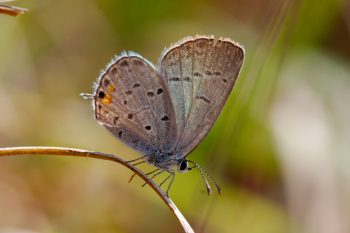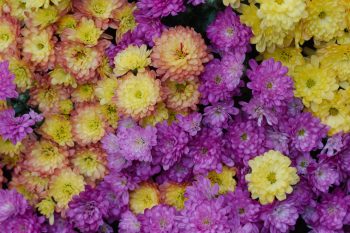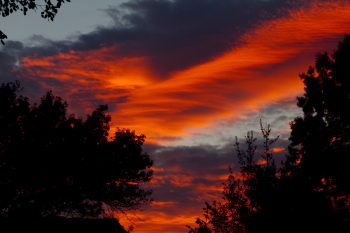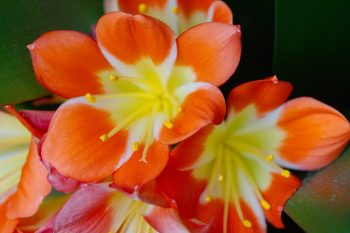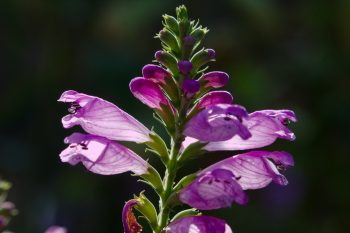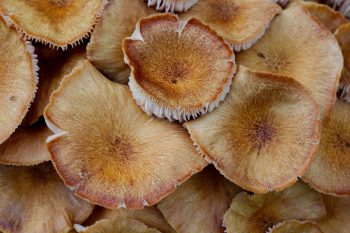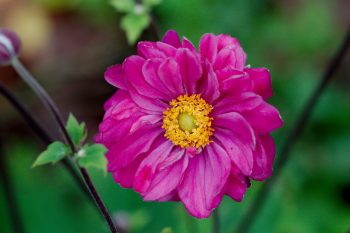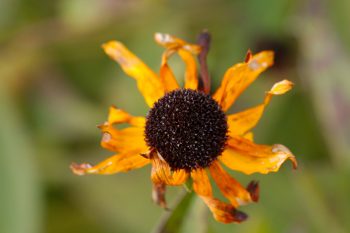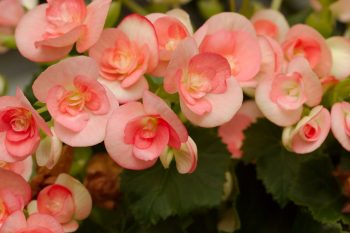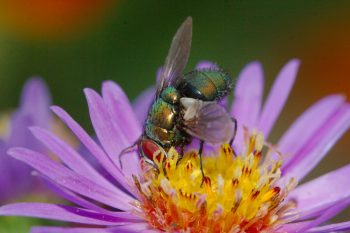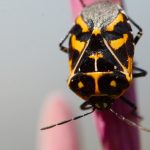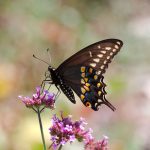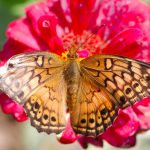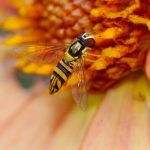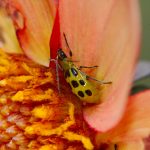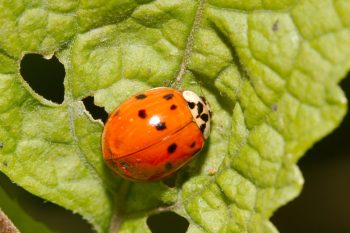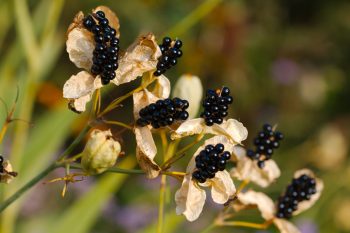We drove to Virginia today and Margaret met two friends for lunch at a Persian restaurant called Shamshiry. The name comes from comes from the Farsi word for a curved sword from the Middle East. While they had lunch, Cathy and I ran some errands. We tried to go to a bakery but were stymied by an Octoberfest that had some streets closed to auto traffic. We made our way around that and headed back to pick up Margaret. I took a few photos of her with her friends, Shaima, and Inez, one of which is my photo for today.
Cupido comyntas (Eastern Tailed-Blue)
I went outside today and walked around a bit in the lot next to my office. The weather was fine and it was nice to be out in the sunshine. I startled a belted kingfisher (Megaceryle alcyon) as I walked towards a vernal drainage pond. It’s often completely dry by this time of year but it had more water in it than in previous years and it hasn’t all evaporated yet. Above it, I was able to get close enough to get a pretty good photograph of this eastern tailed-blue (Cupido comyntas). They are pretty common but easily missed, as they are fairly small and flit around near the ground. They’re worth looking out for, I think.
Chrysanthemums
Although chrysanthemums (a.k.a. mums) are fairly hardy herbaceous perennials, most of us grown them as annuals, bringing them out in the fall to add color to an otherwise less colorful garden. The Rudbekia are done blooming and even the Buddleia are starting to fade. There are still roses on the more ever-blooming varieties, but most of the summer flowers are done for the year. Enter the humble and yet lovely chrysanthemum. We have a few in pots that have been given or that we bought. This one is sitting outside our front door and greeting us as we leave and again when we return home. Who could ask for anything more?
Sunset
I looked around for something to photograph this evening and settled on a flour canister. It’s made of brushed metal (probably aluminum) and has the word FLOUR in a nice, mid-century modern font running vertically down it. I took ot out onto the patio and got some nice photos.
Relaxing on the patio after that, I watched the western sky begin to color and I realized I wasn’t going to use my flour canister photo today. I had to move around the yard to get a good angle between the trees, but I think you’ll agree it was worth it.
Crataegus viridis ‘Winter King’
When I got rid of the nearly dead Colorado blue spruce (Picea pungens) in our front yard, we wanted to replace it with something small but with a little more interest. We decided on a hawthorn and last week I ordered this Crataegus viridis ‘Winter King’ and it was planted yesterday. The leaves are a little dry but it seems pretty healthy and I’m looking forward to the white blossoms in the spring as well as the fruit that you can see is on it now. The green hawthorn is more disease resistant than most hawthorns and ‘Winter King’ was selected, among other reasons, for that reason. This variety is also “noted for its profuse bloom of flowers, larger fruits, silvery-barked stems and more attractive fall color (purple and scarlet).”
Clivia miniata (Natal Lily)
I have had this Clivia for quite a few years now, since a coworker left it to me when she stopped working here. I had it at home for a while but two years ago I brought it to my office and it’s been doing pretty well. It gets literally no direct sun light with my north-facing window but it seems to be doing well with that. They don’t tolerate frost and are grown as houseplants here but they must be wonderful in a garden in their native South Africa and Swaziland. The blooms, as you can see, are quite bright and vary a bit from the orange seen here to yellow and nearly red. Thank you, Emily, for this long-lasting gift.
Physostegia virginiana (Obedient Plant)
I took some photos of the obedient plant (Physostegia virginiana) blooms in the back garden this evening. They are quite pretty when back lit by the sun, as they are here. I was hoping to find some insects to photograph but for whatever reason, there weren’t many this time. There were occasional bees and skippers but I wasn’t able to get close enough to them to photograph. I did manage to get some photos of a sweat bee on the Asclepias but they were not very sharp, so I’ll pass on sharing them.
An Unexpected (But Very Welcome) Visit
Margaret had an unexpected call from and visit by some friends today. Unexpected, but very welcome. Henry and Dieu live in Florida, which is the main reason the visit was so unexpected. They happened to be in town visiting family and came to say hello to Margaret while they were here. They came with Henry’s sister, brother-in-law, and uncle and it was lovely to see them. It was nice to get caught up on their lives and that of their son, Phillip, who is a couple months younger than Dorothy. They posed for a few quick pictures with Margaret before they left.
Mushrooms
It’s that time of year again. The roots of the trees that used to be in our back yard are home to a few varieties of fungus. This time of year, they send up their fruiting bodies and spread their spores to the wind. The most plentiful are these soft brown mushrooms. They come up and are there for a day or two and then turn to mush. Insects of one kind or another lay their eggs in them and the larvae eat the rotting mushrooms. They’re actually pretty gross when in that state, but right now they are sort of pretty.
A mushroom walks into a bar. The bartender says, “We don’t serve mushrooms here.” The mushroom replies, “But I’m a fungi!”
Japanese Anemone
We’ve admired anemones in other peoples’ gardens for years and on occasion we’ve tried to grow them in ours but so far, nothing has taken. Cathy bought this one the other day from Stadler Nursery in Laytonsville and we’re going to give it another try. They really are lovely flowers and pretty plants in general. Hopefully we find the right spot for it where it can thrive and where we can enjoy it on a regular basis for years to come.
Resistance is Futile
“Resistance is Futile. You will be assimilated.” So spoke the Borg when meeting other species. Scott Adams used a variation—“It’s useless to be a resistor”, if memory serves— in one of his Dilbert strips. There are t-shirts with the phrase “Resistance is Futile (if < 1 ohm)” (with some variation in the actual number of ohms required for resistance to be futile). Those, I believe, are aimed at the intersection between Star Trek fans and electrical engineers (or whatever the category would be that will get the electronics reference). Anyway, this is a multi-meter showing a hair over 50 ohms of resistance.
Black-eyed Susan
The black-eyed Susans in the yard are mostly finished now. The petals are drying up and falling off. Soon there will be nothing left but the stalks and seed heads. We generally leave those for the birds to eat during the winter. They seem to be pretty popular with the gold finches, in particular. This isn’t as good a picture as I hoped it would be. It was fairly late in the day and I didn’t bother to get my tripod, so I wasn’t able to get the depth of field that I should have. Still, I like the colors quite well. This is what autumn is about.
Winter-flowering Begonia
With more than 1,800 species, the genus Begonia is one of the largest genera of flowering plants. That doesn’t take into account a multitude of hybrids and cultivars. I have no idea what this variety is, but it’s a pretty, winter-flowering begonia and that’s all that really matters. There are hardy begonias but this isn’t one of them. So, it’s on a table in our dining room and provides some color, along side two deep purple African violets and sheltered by a large (and growing) fiddle-leaf fig (Ficus lyrata) and a fairly old pathos plant (Epipremnum aureum).
Margaret’s Birthday
We went to lunch for Margaret’s birthday today, meeting two of her friends for Iranian kebabs at a place in Germantown called Johnny’s Kabobs (an valid alternative spelling, apparently). Their menu is a bit more extensive than Moby Dick, a local chain, but similar otherwise. It wasn’t particularly busy but that meant that I didn’t have to bother other customers by using my flash, so I was able to take a few pictures. This one is, I think the best, although one of the heads in this photo came from a different exposure. Getting four people to smile all at once is harder than it ought to be.
Blow Fly
I took pictures of insects on aster flowers this evening. There was a bumble bee covered with little white dots that I’m pretty sure were eggs of some kind and didn’t bode well for the little critter. There was also a beautiful, metallic green, sweat bee (family Halictidae) and I got a picture of it as it lifted off the flower, which would have been amazing if it had been in better focus. The light was relatively low and I was using a flash with a white reflector for these pictures, which helped considerably. I also had a 25mm extension tube behind my 100mm macro lens, which helped me get that much closer.
Stink Bug
I happened to look out my window this afternoon and saw this stink bug on the outside of the glass. Actually, it’s not unusual to see them inside the building. My guess is that this is a brown marmorated stink bug (Halyomorpha halys) but I’m not entirely sure and I’m not going to bother looking harder at it. The banded antennae are distinctive, along with the mottled color, but again, that’s just a guess and it’s good enough for me. I also took some pictures this evening of a hardy begonia that’s growing outside our front door. Those are probably prettier than this, being pink and yellow instead of tan (and buggy). But they weren’t as good as I’d like and I can always try to get better pictures, when the light is a bit stronger.
“New” Car
It’s been a busy season for us in terms of cars. We’ve been dealing with our aging fleet for some time. In July, Dorothy left with her cousin in what was meant to be the final journey for our 2000 Chrysler Town and Country. The plan was for them to drive via Chicago to Albuquerque and the car would then be sold for scrap. They made it to Chicago and that’s where it died (the brakes failed completely). They made the rest of the trip in a rental car. We replaced that with a 2007 Town and Country, bought from the parents of a coworker. We also need to unload the Mercury Villager that belongs to Cathy’s mom. It’s ready to go. Well, my brother George came to our rescue by offering us his 2006 Honda Accord. It’s in really good shape and it’s our first sedan of any description for quite some time. I got it registered today, so I figured I’d take a few pictures.
Insects
I went on a short outing this afternoon to the Agricultural Farm Park today and spent a little time wandering around the Master Gardener’s display garden. Mostly I photographed insects (and a few flowers). It was a pretty productive outing as far as insect photos go.
- Danaus plexippus (Monarch) Caterpillar
- Murgantia histrionica (Harlequin Bug)
- Papilio polyxenes asterius (Black Swallowtail)
- Euptoieta claudia (Variegated Fritillary)
- Allograpta obliqua (Common Oblique Syrphid)
- Diabrotica undecimpunctata (Spotted Cucumber Beetle)
I’m particularly happy with the oblique syrphid fly, as that’s the first one I’ve photographed. The black swallowtail is one we don’t see nearly as often as the eastern tiger swallowtail. I’ve seen harlequin bugs on occasion but not all that often. The same is true of the cucumber beetle.
Harmonia axyridis (Asian Lady Beetle)
This is the “many-named ladybird”. It has been called ‘multicolored’ (or ‘multicoloured’ in Britain), ‘multivariate’, ‘southern’, ‘Japanese’, ‘Asian’, ‘Halloween’, ‘harlequin’ and ‘pumpkin’ ladybird/ladybug/ladybeetle. I’m going with the simple ‘Asian’ and sticking to beetle, because it’s in the order Coleoptera. It’s a largish lady beetle and this particular species is immensely variable. The “standard” is red to red-orange with 18 spots, but as you can see, this one only has 12 (six on each side). The background ranges from a slightly orangy yellow to red and there are even versions with red spots on a black background.
Blackberry Lily (Iris domestica)
The flowers on this plant, Iris domestica, the blackberry lily, don’t really give much clue to their common name. When they go to fruit, however, it’s a little clearer where that comes from. They do have a certain blackberry-like look to them. The flowers are a bright orange and are really lovely. The leaves are very iris-like and are beautiful, sculptural fans of varying shades of green. In fact, I’d be tempted to grow these even if they leaves were all they provided. But the flowers are welcome and I like the fruit, as well. We scatter these fairly liberally around the garden and they are now coming up in various places. They aren’t so aggressive that we worry about them taking over, either, which is nice.


